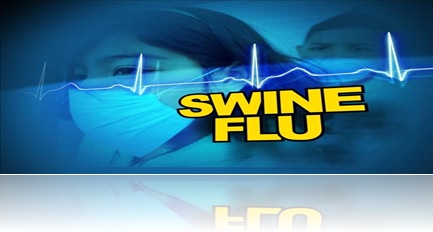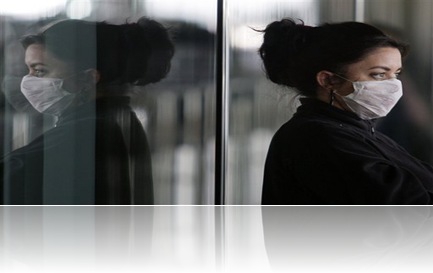The source of the following fact sheet can be found here.
FACTS SHEET – INFLUENZA A (H1N1)
What is influenza – A(H1N1)
Influenza – A (H1N1) (earlier know as swine flu) is a new influenza virus causing illness in people. First detected in Mexico in April, 2009, it has spread to many countries in the World. Swine flu is basically a misnomer. This was originally referred to as “swine flu” because laboratory testing showed that many of the genes in this new virus were very similar to those found in pigs in North America. Further on, it has been found that this new virus has gene segments from the swine, avian and human flu virus genes. The scientists calls this a ‘quadruple reassortant” virus and hence this new (novel) virus is christened “influenza-A (H1N1) virus.”
Influenza A(H1N1) outbreak
It is causing an epidemic among humans in Mexico and it has spread to Argentina, Australia, Austria, Belgium, Brazil, Canada, Chile, China, Colombia, Costa Rica, Cuba, Denmark, Ecuador, El Salvador, Finland, France, Germany, Guatemala, India, Ireland, Israel, Italy, Japan, Republic of Korea, Malaysia, Netherlands, New Zealand, Norway, Panama, Peru, Poland, Portugal, Spain, Sweden, Switzerland, Thailand, Turkey, UK and USA.
Are there human/infections with influenza – A (H1N1) in India?
One passenger who traveled to India from USA has tested positive for Influenza A [H1N1]. There is no furt her spread from him. Do not panic!
Is it safe to take pork items?
Pigs have nothing to do with this disease. Pork products are absolutely safe if properly cooked. There is no need to cull pigs. Do not panic if some pigs die in the community due to natural disease.
Is this flu virus contagious?
Influenza A (H1N1) virus is contagious and spreading from human to human.
What are the signs and symptoms of influenza-A (H1N1) in people?
The symptoms of swine flu in people are similar to the symptoms of regular seasonal flu and include fever, cough, sore throat, body aches, headache, chills and fatigue. Some people have reported diarrhea and vomiting associated with influenza-A (H1N1)
How does influenza-A (H1N1) spread?
Flu viruses are spread mainly from person to person through droplets created while coughing or sneezing by a person infected with the influenza-A (H1N1).
How can someone with the flu infect someone else?
Infected person may be able to infect others beginning one day before symptoms develop and up to seven or more days after becoming sick.
How to keep away from getting the flu?
First and most important: Follow simple steps as cough etiquettes (covering mouth & nose with handkerchief or tissue paper while coughing), stay at least an arm’s length from persons coughing or sneezing, avoid gathering and wash your hands frequently. Try to stay in good general health. Get plenty of sleep, be physically active, manage your stress, drink plenty of fluids and eat nutritious food.
Are there medicines to treat this flu?
Yes. Necessary medicines in sufficient quantity are available. The Government has in the designated hospitals stored medicines if required. It is strongly advisable not to take medicines of your own, as it will lower your immunity.
What can I do to protect myself from getting sick?
(a) Cover your nose and mouth with a tissue when you cough or sneeze. Throw the tissue in the trash after you use it.
(b) Wash your hands often with soap and water, especially after you cough or sneeze. Alcohol-based hand cleaners are also effective.
(c) Avoid touching your eyes, nose or mouth. Germs spread this way.
(d) Try to avoid close contact with people having respiratory illness.
(e) If one gets sick with influenza, one must stay at home, away from work or school and limit contact with others to keep from infecting them. However, if one is having any respiratory distress, one should report to a nearby hospital.
What steps Government of India taking to prevent outbreak of this flu in India?
(1) The strategy is basically to detect early cases among the passengers coming from the affected countries either by air, road or ship.
(2) The Government has launched a massive mass media campaign to inform and educate people on dos and do nots.
(3) Sharing information with public through media.
APPEAL
People who have traveled from the affected countries in the past ten days and show symptoms of influenza A (H1N1) like fever, cough, sore throat and difficulty in breathing should immediately contact the telephone number given below or the nearby Government Hospital.
IMPORTANT CONTACT NUMBERS:
Outbreak Monitoring Cell (Control Room, NICD): 011-23921401
Important Websites:
www.mohfw.nic.in; www.nicd.nic.in
The source of the revised guidelines can be found here.
Revised Guidelines for testing of persons with flu like symptoms reporting at hospitals notified for influenza H1N1
So far, the present guidelines stipulate that a person suspected of influenza A H1N1 need to be referred to an identified govt. health facility. He/she needs to be kept in an isolation facility in that hospital and if found positive, is treated accordingly.
In order to make the testing facility for H1N1 more accessible at large and due to the onset of the Influenza season in the country, it has been decided to revise the existing guidelines.
Under the new guidelines, any person with flu like symptoms such as fever, cough, sore throat, cold, running nose etc. should go to a designated Government facility for giving his/her sample for testing for the H1N1 virus. After clinical assessment, the designated medical officer would decide on the need for testing. Except for cases that are severe, the patient would be allowed to go home (This was not allowed under the existing guidelines).
The sample of the suspect case would be collected and sent to the notified laboratory for testing. If tested as positive for H1N1 and in case the symptoms are mild, the patient would be informed and given the option of admission into the hospital or isolation and treatment at his own home.
In case the patient opts for home isolation and treatment, he/she would be provided with detailed guidelines / safety measures to be strictly adhered to by the entire household of the patient. He/ she would have to provide full contact details of his entire household. The house hold and social contacts would be provided with the preventive treatment.
Notwithstanding the above guidelines, the decision of the doctor of the notified hospital about admitting the patient would be final.
In case the test is negative, the patient will accordingly be informed.
These guidelines have been issued by the Government in public interest and shall be reviewed from time to time depending on the spread of the pandemic and its severity in the country. These guidelines would however not apply to passengers who are identified through screening at the points of entry. The existing policy of isolating passengers with flu like symptoms would continue.
Useful Links which contain more detailed information about Swine Flu.
Ministry of Health & Family Welfare (Govt. of India) – http://mohfw.nic.in/SWINEFLU.htm
Wiki – http://en.wikipedia.org/wiki/2009_flu_pandemic#Symptoms_and_expected_severity
WHO – http://www.who.int/csr/disease/swineflu/en/index.html
A group of techies have created the following useful website to give information about swine flu for the benefit of all.
http://www.swinefluindia.com/symptoms.html
Please be aware of the symptoms of Swine Flu and follow the safety precautions. Consult a doctor immediately if you see any symptoms.


Leave a comment